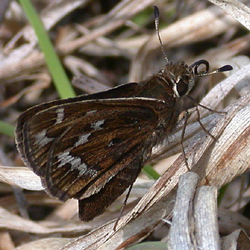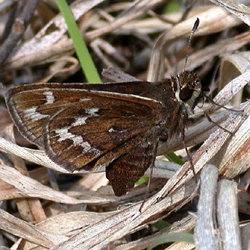Butterfly Atlas
Find a Butterfly
Cobweb Skipper
Hesperia metea
Named
Scudder, 1864

Identification
Wingspan 1 - 1 3/8". Males a distinctive tawny or bronzy brown above; slightly larger females duller. Typical males and females easily recognized by the elaborate underside pattern consisting of large whitish to yellowish spots connected by a cobwebby like tracery of whitish veins. Darker females with a finer spotting pattern might be confused with smaller Pepper and Salt Skipper, but are notably larger and never have the latter species‘ checkered wing margins. The flight period of these two species barely overlap. The only other small skippers likely to be flying in old fields in May are the larger, very dark Dusted Skipper and the larger, more orange Indian Skipper, which begins emerging at the end of Cobweb‘s flight period.
Distribution
Eastern United States from eastern Minnesota and eastern Texas east to southern New England and Georgia. A spotty distribution within this range; absent, for example, from the southeastern coastal plain and from large areas of the central eastern states. No Canadian records. In New England this species just reaches southern Vermont and New Hampshire and the southeast corner of Maine.
Status in Massachusetts
Locally fairly common to occassionally abundant during its brief early flight period. Atlas records seem to indicate that the species is less common and/or more sporadic in the central and western part of the state. This may be related to the prevalence of appropriate habitat/food plants and/or to poor coverage of some areas early in the season. Not found on Nantucket by Atlas workers or Kimball and the only Martha‘s Vineyard record appears to be a single individual found in a light trap at Vineyard Haven on 26 May 1939 by L.W. Cleveland (Kimbal and Jones, 1943). Scudder (1889) seems to have been relatively unfamiliar with this species and regarded it as uncommon and very local. Maximum: 75 at Medfield (Norfolk Co.) on 15 May 1986.

Flight Period in Massachusetts
Flies early and briefly, early May to early June, peaking around the third week of May. Extreme dates: 4 May 1991, Worcester (Worcester Co.), T. Dodd and 5 June 1994, Sudbury (Middlesex Co.), R. Forster. Scudder (1889) says that this species "continues on the wing throughout June", but we can find no records to support this assertion.
Larval Food Plants
In Massachusetts strongly associated with Little Bluestem or Beardgrass (Schizachyrium [Andropogon] scoparia). Also reported from the closely related Big Bluestem (Andropogon gerardi) and Broomsedge (A. virginicus) (Scott, 1986) both of which also occur here.
Adult Food sources
Seems to use many of the early blooming plants that are available during its flight period, e.g. Wild Strawberry, Wild Geranium, cinqfoils, mustards , heaths, and violets.

Habitat
Old fields, barrens and other open areas of poor, well-drained soils dominated by Little Bluestem Grass.
Life Cycle
EGGS: Dome-shaped, dull parchment white and smooth (minute punctures). OVIPOSITION: Eggs laid singly on or near the food plant; hatching in c. two weeks. LARVA: Generally gray-brown with a white neck and black collar; head black with orange markings; shelters in a rooled leaf tied with silk. CHRYSALIS: Pale brown, smooth. PUPATION: Within the leaf nest near the base of grass clumps. OVERWINTERING STAGE: Mature larva.
Males emerge on the earliest warm days of May, the females a few days later. Adults fly low over tan tangles of last season‘s dead beardgrass, diving down among the stems if pursued and often "sitting tight." They spend as much or more time sunning on open ground, rocks or the tops of low shrubs as they do nectaring on the few plants in bloom at this date. Males frequently perch on the previous year‘s vegetation or emergent growth while females typically stay on or near the ground.
Account Author
Chris Leahy



